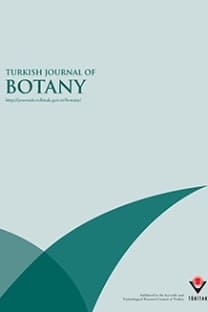The Influence of Certain Physical and Chemical Variables on the Seasonal Dynamics of Phytoplankton Assemblages of a Source Inlet and the Outlet of the Shallow Hypertrophic Lake Manyas, Turkey
Conductivity, phytoplankton biovolume, regression analysis, turbidity, water discharge
The Influence of Certain Physical and Chemical Variables on the Seasonal Dynamics of Phytoplankton Assemblages of a Source Inlet and the Outlet of the Shallow Hypertrophic Lake Manyas, Turkey
___
- Akbay N, Anul N, Yerli S, Soyupak S & Yurteri C (1999). Seasonal distribution of large phytoplankton in the Keban Dam Reservoir. J Plankton Res 21: 771-787.
- Albay M & Akcaalan R (2003). Comparative study of periphyton colonization on common reed (Phragmites australis) and artificial substrate in a shallow lake, Manyas, Turkey. Hydrobiologia 506- 509: 531-540.
- APHA (1995). Standard Methods for the Examination of Water and Wastewater. 17th Ed. Washington: American Public Health Association.
- Arhonditsis GB, Winder M, Brett MT & Schindler DE (2004). Patterns and mechanisms of phytoplankton variability in Lake Washington (USA). Water Res 38: 4013-4027.
- Buyukisik B & Parlak H (1989). Investigation on ecology of the Bird lake Bandırma. Ankara University Journal of Fisheries 6: 160- 175.
- Dinka M, Agnoston-Szab E, Berczik A & Kutrucz G (2004). Influence of water level fluctuation on the spatial dynamic of the water chemistry at Lake Fert6/Neusiedler See. Limnologica 34: 48-56.
- Dokulil MT & Teubner K (2005). Do phytoplankton assemblages correctly track trophic changes? - Assessment from contemporary and palaeolimnological data. Freshwater Biol 50: 1594-1604.
- Geitler L & Pascher A (1925). Cyanophyceae. In: Pascher Die Süßwasser - Flora, Deutschlands, Österreichs und der Schweiz. Heft 12. VEB Gustav Fischer Verlag.
- Huber-Pestalozzi G (1961). Das phytoplankton des Süsswassers. Systematik und Biologie, 5 Teil. Chlorophyceae, Ordnung Volvocales. Einzeldarnstellungen Nachbargebieten. Verlagsbuchhandlung. Stuttgart: Jena. Die Limnologie E. XVI.
- Schweizerbart`sche Band.
- Karafistan A & Arık-Çolakoğlu F (2005). Physical, chemical and microbiological water quality of the Manyas Lake, Turkey. Mitig Adapt Strat Glob Change 10: 127-143.
- Kelly M (2000). Identification of common benthic diatoms in Rivers. FSC 9: 583-700.
- Köhler J (1994). Origin and succession of phytoplankton in a river-lake system (Spree, Germany). Hydrobiologia 289: 73-83.
- Leroy S, Kazancı N, Ileri Ö, Kibar M, Emre O, McGee E & Griffiths HI (2002). Abrupt environmental changes within a late Holocene lacustrine sequence south of the Marmara Sea (Lake Manyas, N- W Turkey): possible links with seismic events. Mar Geol 190: 531-552.
- Muylaert K, Sabbe K & Vyverman W (2000). Spatial and temporal dynamics of phytoplankton communities in a freshwater tidal estuary (Schelde, Belgium). Estuar Coast Shelf S 50: 673-687.
- Olding DD, Hellebust JA & Douglas MSV (2000). Phytoplankton community composition in relation to water quality and water- body morphometry in urban lakes, reservoirs, and ponds. Can J Fish Aquat Sci 57: 2163-2174.
- Perkins RG & Underwood GJC (2000). Gradients of chlorophyll a and water chemistry along an eutrophic reservoir with determination of the limiting nutrient by in situ nutrient addition. Water Res 34: 713-724.
- Reynolds CS, Huszar V, Kruk C, Naselli-Flores L & Melo S (2002). Towards a functional classification phytoplankton. J Plankton Res 24: 417-428. of the freshwater
- Reynolds CS (1984). The Ecology of Freshwater Phytoplankton. Cambridge: Cambridge University Press.
- Reghunathr R, Murthy TRJ & Raghavan BR (2002). The utility of multivariate statistical techniques in hydrogeochemical studies: an example from Karnataka, India. Water Res 36: 2437-42.
- SAS Institute (1990). SAS/STAT Users Guide. 4th ed. Cary: North Carolina.
- Shipin OV, Rose PD & Meirin PGJ (1999). Microbial processes underlying the PETRO concept (trickling filter variant). Water Res 33: 1645-1651.
- Sun J & Liu D (2003). Geometric models for calculating cell biovolume and surface area for phytoplankton. J Plankton Res 25: 1331- 1346.
- Tatrai I, Matyas K, Korponai J, Szabo G, Pomogyi P & Heri J (2005). Response of nutrients, plankton communities and macrophytes to fish manipulation in a small eutrophic wetland lake. Int Rev Hydrobiol 90: 511-522.
- Temponeras M, Kristiansen J & Moustaka-Gouni M (2000). Seasonal variation in phytoplankton composition and physical-chemical features of the shallow Lake Doïrani, Macedonia, Greece. Hydrobiologia 424: 109-122.
- Turkish Ministry of Environment (1997). The Environmental Report for the City of Balıkesir. Ankara, Turkey.
- ISSN: 1300-008X
- Yayın Aralığı: 6
- Yayıncı: TÜBİTAK
Combining Ability Analysis of Yield and Yield Components in Tomato (Lycopersicum esculentum Mill.)
Mohammad Mofidul HANNAN, Manosh Kumar BISWAS, Mohammad Bulbul AHMED, Monzur HOSSAIN, Rafiul ISLAM
Macrofungi of Çameli District (Denizli-Turkey)
Aziz TÜRKOĞLU, Abdurrahman KANLIK, Kudret GEZER
Solanum elaeagnifolium Cav. in Turkey
The Flora of Akçadağ (Van-Turkey)
Studies on the Hornworts and Liverworts Flora of Antalya
Hatice ÖZENOĞLU KİREMİT, Atakan SUKATAR, İsa GÖKLER
A New Record for Turkey: Lepidium pinnatifidum Ledeb. (Brassicaceae)
Murat ÜNAL, Fevzi ÖZGÖKÇE, Lütfi BEHÇET, Osman KARABACAK
Kadry N. ABDEL-KHALIK, Freek T. BAKKER
The Family Boletaceae s.l. (Excluding Boletus) in the Republic of Macedonia
